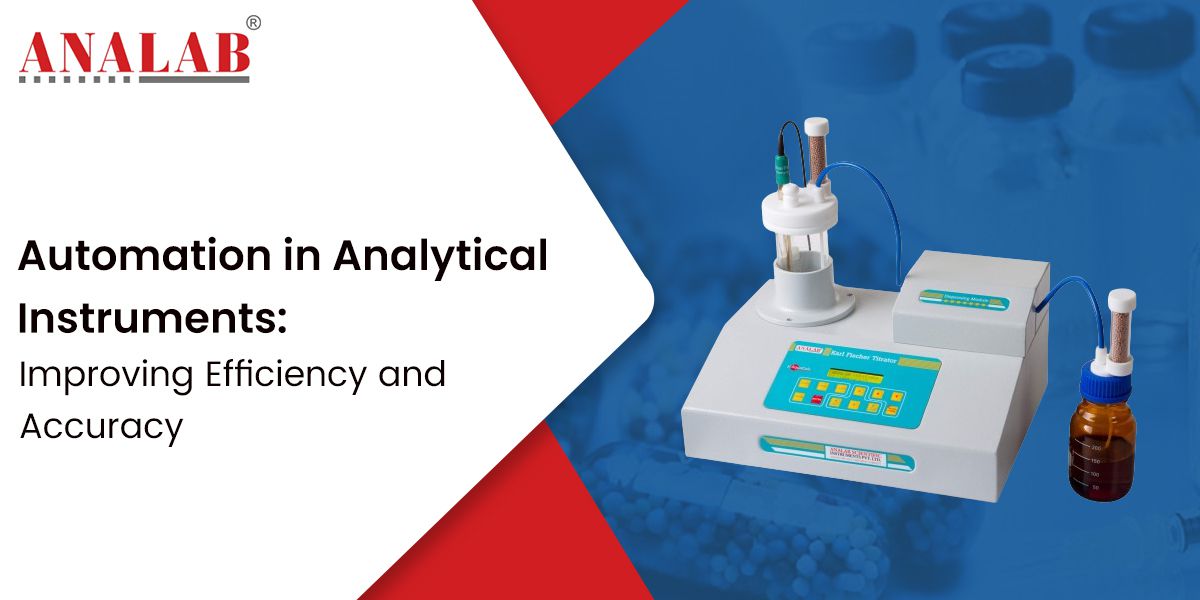
30 Jan 2024
In the realm of analytical laboratory instruments, AnaLab Scientific Equipments is the reliable partner you can rely on. Being the leading Analytical laboratory instruments exporter in India, we are aware of the significance that efficiency and accuracy have in the processes that are used in the scientific community. This article delves into the revolutionary impact of automation in analytical equipment, elaborating on how it improves productivity, precision, and dependability in laboratory operations. Specifically, we focus on how automation brings about these improvements.
Different businesses, such as the pharmaceutical industry, the food and beverage industry, environmental monitoring, and research institutes, all rely heavily on analytical laboratories to perform their functions. Since there has never been a time when there was a greater demand for accurate and trustworthy analytical data, there has been a need for breakthroughs in instrumentation technology. In the process of reinventing the way analyses are carried out and the findings are obtained, automation emerges as a game-changing innovation.
We at AnaLab Scientific Equipments are at the forefront of integrating automation into our analytical equipment, which is causing a paradigm shift in the workflows that are utilized in laboratories. Let's investigate how automation improves the efficiency and accuracy of various types of analytical instruments with the following examples:
Chromatography techniques, which include High-Performance Liquid Chromatography (HPLC) and Gas Chromatography (GC), are fundamental approaches in the field of analytical chemistry. Sample preparation, injection, and data analysis are all operations that can be streamlined through the use of automation in chromatography systems. Sample injectors that are automated provide accurate volumes, which in turn reduces the likelihood of human mistakes and improves reproducibility. Integration with software makes remote monitoring and control easier, which in turn maximizes the amount of time that instruments are operational and increases production.
When it comes to quantitative investigation of substances based on their absorbance or emission of electromagnetic radiation, spectrophotometry is an indispensable tool. Several functions are available on automated spectrophotometers, including auto-calibration, wavelength scanning, and data processing algorithms. These technological innovations not only speed up the analysis process but also reduce the amount of operator intervention, which in turn reduces the likelihood of errors and enhances the consistency of the results.
Mass spectrometry is a technique that allows for the identification and quantification of molecules based on the ratio of their mass to their charge. The operations of sample introduction, ionization, and data collecting are all included in the purview of mass spectrometers that are automated. Robotic autosamplers make it possible to perform high-throughput analysis on many samples, and software-driven workflows make it easier to create and optimize methods. Researchers are given the ability to unravel complicated molecular structures with more precision thanks to these automated functionalities, which improve analytical throughput and data quality.
Precision weighing is an essential component of analytical chemistry since it plays a significant role in determining the precision of concentration measurements and formulation procedures. The built-in calibration algorithms, anti-static devices, and draft shields that are included in automated analytical balances ensure that the weighing process is completely correct. In addition, networking options make it possible to transfer data to LIMS (Laboratory Information Management Systems), which guarantees traceability and complies with regulatory standards.
Acid-base, redox, and complexometric titrations are all examples of applications that make extensive use of titration, which is a versatile tool for quantitative chemical investigation. The process of automating titration procedures is accomplished via automated titration systems through the utilization of motorized burettes, robotic sample dispensers, and endpoint detection algorithms. In addition to accelerating the analysis process, this eliminates the human-made mistakes that are inherent with manual titrations, which in turn improves the reproducibility of the results.
XRD is a strong technique that may be used to characterize crystalline materials and shed light on their structure and behaviour. X-ray diffraction (XRD) systems that are automated incorporate sample changers, goniometers, and detectors that are managed by intelligent software. It is possible to conduct high-throughput analyses of crystalline phases, polymorphs, and crystallite sizes thanks to these automation features, which contribute to the advancement of materials research and development.
In addition to enhancing efficiency and accuracy, automation in analytical instruments offers several compelling benefits for laboratory professionals and organisations:
At AnaLab Scientific Equipments - the most reliable Analytical Instruments Exporter, we are committed to empowering laboratories with cutting-edge automation solutions that elevate their analytical capabilities and drive scientific innovation. Whether you are a research institution, pharmaceutical company, or environmental testing laboratory, our comprehensive range of automated analytical instruments caters to your diverse needs with uncompromising quality and reliability.
Automation in analytical instruments represents a transformative force that revolutionises laboratory operations, enhancing efficiency, accuracy, and productivity. Being a trusted Analytical laboratory instruments manufacturer in India, AnaLab Scientific Equipments continues to lead the charge towards a future where scientific breakthroughs are powered by automation.
Experience the difference automation can make in your laboratory with AnaLab Scientific Equipments - an excellent Analytical laboratory instruments supplier in India. Contact us today to explore our innovative solutions tailored to your analytical needs. Let's embark on a journey of discovery and excellence together!